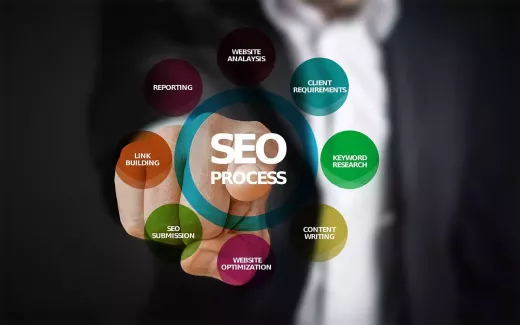What is SEM?
SEM, or Search Engine Marketing, is the practice of promoting your website through paid advertising on search engine results pages (SERPs). SEM includes a variety of tactics, including pay-per-click (PPC) advertising, display advertising, and retargeting. The goal of SEM is to drive traffic to your website and increase conversions by placing ads in front of people who are actively searching for your products or services.
Search engines like Google, Bing, and Yahoo have advertising platforms that allow businesses to create and manage ad campaigns that appear on their search results pages. These ads appear above or below the organic search results and are labeled as ads. SEM is different from SEO (Search Engine Optimization), which focuses on optimizing your website to improve your organic ranking in search results.
The difference between SEO and SEM
SEO and SEM are often used interchangeably, but they are two distinct practices. SEO involves optimizing your website to rank higher in organic search results, while SEM involves paying for advertising to appear at the top of search results pages. SEO is a long-term strategy that requires ongoing optimization and maintenance, while SEM can provide immediate results but requires ongoing investment.
SEO focuses on optimizing your website's content, structure, and technical elements to improve your organic ranking in search results. This involves keyword research, on-page optimization, link building, and technical SEO. SEM, on the other hand, involves creating and managing ad campaigns that appear on search results pages. SEM can be more expensive than SEO, but can provide a higher return on investment (ROI) if managed effectively.
The benefits of SEM
There are several benefits to using SEM as part of your digital marketing strategy. Here are some of the key advantages:
1. Targeted advertising
SEM allows you to target specific keywords and phrases that are relevant to your business. This means that your ads will be shown to people who are actively searching for your products or services, making them more likely to convert.
2. Immediate results
Unlike SEO, which can take months to see results, SEM can provide immediate results. By creating and launching ad campaigns, you can start driving traffic to your website and generating leads and sales right away.
3. Measurable ROI
SEM provides detailed metrics that allow you to track the performance of your ad campaigns. You can see how many clicks, impressions, and conversions your ads are generating, and adjust your campaigns accordingly to improve your ROI.
4. Flexibility and control
With SEM, you have full control over your ad campaigns, including your budget, targeting, and ad copy. This allows you to make changes and optimizations on the fly to improve your results.
SEM statistics
Here are some SEM statistics that highlight the importance of SEM for businesses:
- 93% of online experiences begin with a search engine (Search Engine Journal) - Google Ads has a 7:1 ROI (Google) - 65% of all clicks on paid ads are made by users who are ready to make a purchase (WordStream) - 41% of clicks go to the top 3 paid ads on the search results page (WordStream)
SEM strategy
Creating a successful SEM strategy involves several key components. Here are the steps you should follow:
1. Define your goals
Before you can start creating ad campaigns, you need to define your goals. What do you want to achieve with your SEM efforts? Do you want to drive more traffic to your website? Generate more leads? Increase sales? Once you have defined your goals, you can create ad campaigns that are tailored to achieve those goals.
2. Conduct keyword research
Keyword research is the foundation of any successful SEM campaign. You need to identify the keywords and phrases that your target audience is using to search for your products or services. This involves using tools like Google Keyword Planner to research search volume, competition, and cost-per-click (CPC) for your target keywords.
3. Create ad campaigns
Once you have identified your target keywords, you can create ad campaigns that are tailored to those keywords. This involves creating ad copy, choosing ad formats (text ads, display ads, etc.), and setting your targeting options (location, language, device, etc.).
4. Monitor and optimize your campaigns
SEM requires ongoing monitoring and optimization to ensure that your campaigns are performing at their best. This involves analyzing your metrics, adjusting your targeting and bids, and testing different ad copy and formats to improve your results.
Creating your SEM plan
To create a successful SEM plan, you need to follow these steps:
1. Define your budget
Before you can start creating ad campaigns, you need to define your budget. How much are you willing to spend on SEM? This will determine the scope and scale of your campaigns.
2. Identify your target audience
Who is your target audience? What are their interests, needs, and pain points? This information will help you create ad campaigns that are tailored to your audience.
3. Conduct keyword research
Keyword research is a critical component of your SEM plan. You need to identify the keywords and phrases that your target audience is using to search for your products or services.
4. Create ad campaigns
Once you have identified your target keywords, you can create ad campaigns that are tailored to those keywords. This involves creating ad copy, choosing ad formats, and setting your targeting options.
5. Monitor and optimize your campaigns
SEM requires ongoing monitoring and optimization to ensure that your campaigns are performing at their best. This involves analyzing your metrics, adjusting your targeting and bids, and testing different ad copy and formats to improve your results.
SEM tips for beginners
Here are some tips for beginners who are just getting started with SEM:
1. Start small
Start with a small budget and a few targeted keywords to test the waters. Once you have a better understanding of how SEM works, you can scale up your campaigns.
2. Focus on relevance
Make sure that your ad campaigns are relevant to your target audience. Use targeted keywords, ad copy, and landing pages to ensure that your ads are tailored to your audience's needs.
3. Monitor your metrics
SEM requires ongoing monitoring and optimization. Make sure that you are regularly checking your metrics to identify areas for improvement.
4. Test different ad formats
Experiment with different ad formats, such as text ads, display ads, and video ads, to see which formats work best for your business.
The best SEM tools - Google AdWords, Bing Ads, and Yahoo Gemini
There are several SEM tools available that can help you create and manage ad campaigns. Here are some of the best SEM tools:
1. Google AdWords
Google AdWords is the most popular SEM tool, with over 1 million businesses using it to create and manage ad campaigns. AdWords allows you to create text, display, and video ads that appear on Google's search results pages and partner websites.
2. Bing Ads
Bing Ads is a SEM tool that allows you to create and manage ad campaigns on Bing and Yahoo search results pages. Bing Ads offers similar targeting options and ad formats as Google AdWords.
3. Yahoo Gemini
Yahoo Gemini is a SEM tool that allows you to create and manage ad campaigns on Yahoo search results pages and partner websites. Gemini offers similar targeting options and ad formats as Google AdWords and Bing Ads.
SEM courses for beginners
If you're new to SEM and want to learn more, there are several courses and resources available that can help you get started. Here are some of the best SEM courses for beginners:
1. Google AdWords Certification
Google offers a free certification program that covers the basics of AdWords and SEM. The program includes several courses and exams that cover topics like keyword research, ad creation, and campaign management.
2. Udemy - SEM for Beginners
Udemy offers several courses on SEM, including "SEM for Beginners: Learn the Basics of Search Engine Marketing." This course covers the fundamentals of SEM, including keyword research, ad creation, and campaign optimization.
3. Lynda - SEM Essential Training
Lynda offers a comprehensive course on SEM called "SEM Essential Training." This course covers everything from keyword research to ad creation to campaign optimization, and includes hands-on exercises and quizzes to help you apply what you've learned.






.png?size=50)



